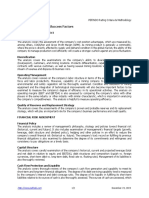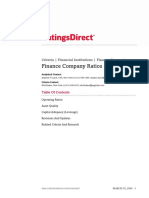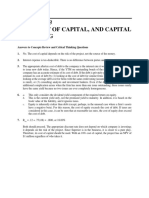Banking Industry - Key Success Factors: Business Risk Assessment Market Position
Banking Industry - Key Success Factors: Business Risk Assessment Market Position
Uploaded by
rahidarzooCopyright:
Available Formats
Banking Industry - Key Success Factors: Business Risk Assessment Market Position
Banking Industry - Key Success Factors: Business Risk Assessment Market Position
Uploaded by
rahidarzooOriginal Description:
Original Title
Copyright
Available Formats
Share this document
Did you find this document useful?
Is this content inappropriate?
Copyright:
Available Formats
Banking Industry - Key Success Factors: Business Risk Assessment Market Position
Banking Industry - Key Success Factors: Business Risk Assessment Market Position
Uploaded by
rahidarzooCopyright:
Available Formats
PEFINDO Rating Criteria & Methodology
Banking Industry - Key Success Factors
BUSINESS RISK ASSESSMENT
Market Position
The analysis includes comprehensive assessments of the bank's market shares and sizes in key business
lines or sectors as well as its future prospect, the bank's existing products, future products, market
expansion, and other real advantages resulting from the bank's market position (pricing power vs. funding
base) either in national market, regional market, or in any specific segment/sector. The vulnerability of the
bank's market position is also considered by comparing its competitive advantages against its peers.
Infrastructure and Quality Of Service
The analysis covers detailed assessments on the bank's distribution network such as branches, ATM, and
IT capabilities to support its daily banking operation in an effort to provide better and integrated products
and give better services to its customers. The bank's quality of service is also diligently assessed, as it is
considered as an important factor for a retail bank to attract customers and support the bank's sustainable
growth, particularly in the intense business competition. Other factors that are also assessed are, among
others, employees' capabilities in providing banking services and handling complaints from customers,
speed of services, accessibility, timeliness, and etc.
Diversification
The analysis covers thorough assessments on the bank's business network/base with regard to
geographical/location spread, business lines, products, revenues structures, customers base of funding and
lending, credit risk (broken down by economic sector, size, and customer base), as well as economic
diversity of the bank's market, etc.
Management & Human Resources
The analysis includes detailed assessments on the bank's quality and credibility of the management and
key personnel, the bank's management strategies to maintain sustainable growths (external and internal),
the bank's quality in financial planning and strategy (aggressive vs. conservative), the bank's organizational
structure, the bank's quality of business, which are generally measured from its underwriting criteria,
process of credit approval, delegation of credit approval and authorities, collateral valuations, monitoring
of credit exposures, internal rating/scoring system, tools or system to identify potential problem exposures
as well as roles and reliabilities of internal audit and compliance department, and the bank's managerial
efficiency and effectiveness. The implementation of good corporate governance, particularly accountability
of the management and transparency of its financial statement, is also reviewed.
FINANCIAL RISK ASSESSMENT
Capitalization
The analysis includes diligent assessments on the bank's capital composition (equity, subordinated debt,
revalued assets, unrealized capital gains, and other types of quasi-reorganization), the bank's capital
position with respect to Central Bank (Bank Indonesia) requirements, level of Capital Adequacy Ratio (total
and Tier 1 CAR), dividend pay out ratio, internal growth rate of capital, ability to get external sources of
capital, capital in comparison with assets, as well as management philosophy and strategy on leveraging
its capital.
Assets Quality
The analysis includes intensive assessments on the bank's non performing loans broken down by category,
the bank's credit portfolio by economic sector, size, and currency, concentration on credit risks (total
exposures to certain industry, company, or individual), settlements on problem loans (past due loans,
http://www.pefindo.com 1/2 April 02, 2019
PEFINDO Rating Criteria & Methodology
restructured loans, or other types of problematic loans), and the bank's loan loss reserve policy and
adequacy. In addition, thorough analysis is also conducted on the qualitative aspects on assets quality such
as whether the bank fully identifies and discloses its problematic loans, the bank's write off policy and
whether the bank implements it rightly, and other credit judgment that can provide clues about the bank's
credit culture, policy, and procedures and the effects into its asset quality.
Profitability
The analysis includes thorough assessments on the bank's net interest income and margin (trends, ability
to grow, as well as sustainability), non interest income (size, diversity, as well as growth potential), quality
of earnings, ability to price risks into various products, operating profits, and net income (trend,
sustainability, and potential growth). The bank's cost structure (trends, ability to raise cheaper funding,
stability, and etc), cost to income ratio (to measure efficiency), and management strategy to control
operational expenses and improve fee based income are also diligently assessed.
Liquidity and Financial Flexibility
The analysis covers the assessments on current market condition and its effect on the bank's liquidity,
examination on the bank's liquidity management (in terms of policy and strategy), and ability to earn
immediate cash flow (internally or externally) and its contingency plans to support its liquidity demand.
The examination on the bank's interest rate and maturity mismatches, net open position, loan to deposit
ratio and evaluation on the proportion of the bank's liquid assets as compared to its short term liabilities
are also incorporated in the assessments. Analysis on financial flexibility includes careful assessments on
the bank's ability to access various funding markets and raise capital from public, or private sources as well
as the likelihood of supports from the government, particularly under distress conditions.
DISCLAIMER
PT Pemeringkat Efek Indonesia (PEFINDO) does not guarantee the accuracy, completeness, timeliness or availability of the contents
of this report or publication. PEFINDO cannot be held liable for its use, its partial use, or its lack of use, in combination with other
products or used solely, nor can it be held responsible for the result of its use or lack of its use in any investment or other kind of
financial decision making on which this report or publication is based. In no event shall PEFINDO be held liable for any direct, indirect,
incidental, exemplary, compensatory, punitive, special or consequential damages, costs, expenses, legal fees, or losses including but
not limited to lost profits and opportunity costs in connection with any use of the contents of this report or publication. Credit analyses,
including ratings, and statements in this report or publication are statements of opinion as of the date they are expressed and not
statements of fact or recommendations to purchase, hold or sell any securities or to make any investment decision. The contents
cannot be a substitute for the skill, judgment and experience of its users, its management employees and/or clients in making
investment or other business decisions. PEFINDO also assumes no obligation to update the content following publication in any form.
PEFINDO does not act as fiduciary or an investment advisor. While PEFINDO has obtained information from sources it believes to be
reliable, PEFINDO does not perform an audit and does not undertake due diligence or independent verification of any information
used as the basis of and presented in this report or publication. PEFINDO keeps the activities of its analytical units separate from its
business units to preserve independence and objectivity of its analytical processes and products. As a result, certain units of PEFINDO
may have information that is not available to other units. PEFINDO has established policies and procedures to maintain the
confidentiality of certain non-public information received in connection with each analytical process. PEFINDO may receive
compensation for its ratings and other analytical work, normally from issuers of securities. PEFINDO reserves the right to disseminate
its opinions and analyses. PEFINDO’s public ratings and analyses are made available on its website, http://www.pefindo.com (free of
charge) and through other subscription-based services, and may be distributed through other means, including via PEFINDO
publications and third party redistributors. Information in PEFINDO’s website and its use fall under the restrictions and disclaimer
stated above. Reproduction of the content of this report, in full or in part, is subject to written approval from PEFINDO.
http://www.pefindo.com 2/2 April 02, 2019
You might also like
- Asset Quality Management in BankDocument13 pagesAsset Quality Management in Bankswendadsilva100% (4)
- BANKING INDUSTRY - Key Success Factors: Business Risk Assessment Market PositionDocument2 pagesBANKING INDUSTRY - Key Success Factors: Business Risk Assessment Market PositionGary YuthianNo ratings yet
- Banking Industry KSFDocument3 pagesBanking Industry KSFAdam AmruNo ratings yet
- Manufacturing Bisnis N Finance RaiskDocument2 pagesManufacturing Bisnis N Finance RaiskFerlyan Huang 正莲No ratings yet
- Key Success Factors of The Pharmaceutical IndsustryDocument2 pagesKey Success Factors of The Pharmaceutical Indsustrybenj_morgan100% (1)
- Automotive Industry - Key Success Factors: Business Risk Assessment Market PositionDocument3 pagesAutomotive Industry - Key Success Factors: Business Risk Assessment Market PositionraghulNo ratings yet
- Information Technology & IT Services IndustryDocument3 pagesInformation Technology & IT Services IndustryAlukwu JudeNo ratings yet
- Retail IndustryDocument3 pagesRetail IndustryakavinashkillerNo ratings yet
- Credit Rating ProjectDocument10 pagesCredit Rating Projectnaman_s7028No ratings yet
- Key Success Facotr GeneralDocument3 pagesKey Success Facotr GeneralprashantNo ratings yet
- Special Financial Institution IndustryDocument2 pagesSpecial Financial Institution IndustryAVINASH KUMAR SINGHNo ratings yet
- Electricity Power Industry - Key Success Factors: Business Risk Assessment RegulationDocument2 pagesElectricity Power Industry - Key Success Factors: Business Risk Assessment Regulationanubhav saxenaNo ratings yet
- Objectives of Credit Rating: Financial Statements CreditworthinessDocument6 pagesObjectives of Credit Rating: Financial Statements CreditworthinessvishNo ratings yet
- Tobacco Industry - Key Success Factors: Business Risk Assessment Market PositionDocument3 pagesTobacco Industry - Key Success Factors: Business Risk Assessment Market PositionGunadeep ReddyNo ratings yet
- Mining Industry - Key Success Factors: Business Risk Assessment Cost PositionDocument2 pagesMining Industry - Key Success Factors: Business Risk Assessment Cost PositionJonas ArifinNo ratings yet
- Toll Road Industry - Key Success Factors: Business Risk Assessment Economy of Service AreaDocument3 pagesToll Road Industry - Key Success Factors: Business Risk Assessment Economy of Service Arealuqm4n99No ratings yet
- Working Capital FinancingDocument44 pagesWorking Capital FinancingShoib ButtNo ratings yet
- CRM 1Document41 pagesCRM 1Arjun PadmanabhanNo ratings yet
- S&P Finance Company RatiosDocument5 pagesS&P Finance Company RatiosVvb SatyanarayanaNo ratings yet
- Critical Succucess FactorDocument3 pagesCritical Succucess FactorHimansh SagarNo ratings yet
- CamelsDocument4 pagesCamelsWaseem KhanNo ratings yet
- Accounting and Finance Marking Guide For Set 2Document5 pagesAccounting and Finance Marking Guide For Set 2Folegwe FolegweNo ratings yet
- Ê They Are Simply Opinions, Based On Analysis of The RiskDocument13 pagesÊ They Are Simply Opinions, Based On Analysis of The RiskMegha ChhabraNo ratings yet
- Financial RatiosDocument4 pagesFinancial RatiosDzul ArifNo ratings yet
- Outsourcing Policy-GuidlinesDocument15 pagesOutsourcing Policy-GuidlinesutoNo ratings yet
- Risk Factors and Risk ManagementDocument12 pagesRisk Factors and Risk ManagementRamela Jean SabanNo ratings yet
- Special Audit C WPS OfficeDocument6 pagesSpecial Audit C WPS OfficeJoshua AseritNo ratings yet
- Outsourcing PolicyDocument13 pagesOutsourcing PolicyShahzad SalimNo ratings yet
- Bsp-Credit Risk ManagementDocument69 pagesBsp-Credit Risk Managementjhomar jadulanNo ratings yet
- Ots Exam Handbook 201Document20 pagesOts Exam Handbook 201Hem Raj HyankiNo ratings yet
- Credit PolicyDocument10 pagesCredit PolicyAyesha KhanNo ratings yet
- Credit AnalysisDocument2 pagesCredit Analysislaharigoud03No ratings yet
- Policy: OP 13.60 - Monitoring and EvaluationDocument4 pagesPolicy: OP 13.60 - Monitoring and Evaluationابوايمن العمراني ايمنNo ratings yet
- Methodology For Rating Banks: Quantitative FactorsDocument3 pagesMethodology For Rating Banks: Quantitative FactorspawanNo ratings yet
- Performance Evaluation Study UnitDocument33 pagesPerformance Evaluation Study UnitTakudzwa MashiriNo ratings yet
- Q1) Rating Methodology Adopted by Credit Rating Anency/ Icra Rating Scale of Corporate GovernanceDocument20 pagesQ1) Rating Methodology Adopted by Credit Rating Anency/ Icra Rating Scale of Corporate GovernanceNikhilNo ratings yet
- Research ProposalDocument7 pagesResearch ProposalmasereshasetteNo ratings yet
- Mod 1Document41 pagesMod 1Raghav Mehra100% (2)
- F Dic Manual ExaminationDocument24 pagesF Dic Manual ExaminationAmir ShaikNo ratings yet
- Final Financial Assessment - 2023Document9 pagesFinal Financial Assessment - 2023Weldu GebruNo ratings yet
- Credit Approval Process Review and Exposure Management Data CollectionDocument21 pagesCredit Approval Process Review and Exposure Management Data Collectionameeque khaskheliNo ratings yet
- Analysis The BankDocument25 pagesAnalysis The BankMonica Rogoz100% (5)
- Lecture 3Document4 pagesLecture 3jntvtn7pc9No ratings yet
- ALCO PolicyDocument13 pagesALCO Policyritabif100% (1)
- A Proposal On Liquidity Analysis of Nepal Investment Bank Limited (Nibl)Document6 pagesA Proposal On Liquidity Analysis of Nepal Investment Bank Limited (Nibl)Samira ShakyaNo ratings yet
- Synopsis: Title: "Financial Statement Analysis of National Bank."Document4 pagesSynopsis: Title: "Financial Statement Analysis of National Bank."Miyana JabirNo ratings yet
- Understanding The Entity and Its EnvironmentDocument6 pagesUnderstanding The Entity and Its Environmentjeric rotasNo ratings yet
- Se No 13 24 DPNP and AppendicesDocument126 pagesSe No 13 24 DPNP and AppendicesMuh Rizki Gus SofwanNo ratings yet
- If DraftDocument4 pagesIf Draftmohamedfarid365No ratings yet
- South Indian BankDocument12 pagesSouth Indian BankAnupriya RajendranNo ratings yet
- UntitledDocument2 pagesUntitledsushil pokharelNo ratings yet
- Chapter 1.2 - The Credit AnalystDocument19 pagesChapter 1.2 - The Credit AnalystRahul ParateNo ratings yet
- Proposal PHD in FinanceDocument14 pagesProposal PHD in FinanceFrancis NgandiNo ratings yet
- Job Description FL Statistical AnalystDocument2 pagesJob Description FL Statistical AnalystK CorNo ratings yet
- "Operational Risk Analysis in Bank'S": Major Research Project OnDocument36 pages"Operational Risk Analysis in Bank'S": Major Research Project OnHemant Singh SisodiyaNo ratings yet
- Chapter-1 Introduction To The StudyDocument70 pagesChapter-1 Introduction To The StudyMOHAMMED KHAYYUMNo ratings yet
- Accolade Wines Downgraded To 'SD' and 301 Millio - S&P Global RatingsDocument7 pagesAccolade Wines Downgraded To 'SD' and 301 Millio - S&P Global Ratingsvitacoco127No ratings yet
- Components of A Sound Credit Risk Management ProgramDocument8 pagesComponents of A Sound Credit Risk Management ProgramArslan AshfaqNo ratings yet
- Investments Profitability, Time Value & Risk Analysis: Guidelines for Individuals and CorporationsFrom EverandInvestments Profitability, Time Value & Risk Analysis: Guidelines for Individuals and CorporationsNo ratings yet
- Course FIMMDA PDFDocument2 pagesCourse FIMMDA PDFrahidarzooNo ratings yet
- QUESTIONSDocument19 pagesQUESTIONSrahidarzooNo ratings yet
- Chapter 13 SolutionsDocument5 pagesChapter 13 SolutionsrahidarzooNo ratings yet
- Financial Year: Freehold Land Is Not DepreciatedDocument1 pageFinancial Year: Freehold Land Is Not DepreciatedrahidarzooNo ratings yet
- Food IndustryDocument17 pagesFood IndustryrahidarzooNo ratings yet
- Application For Birth CertificateDocument2 pagesApplication For Birth CertificaterahidarzooNo ratings yet
- Indian Journal of Economics and Development-2018 PDFDocument9 pagesIndian Journal of Economics and Development-2018 PDFAlpana KumariNo ratings yet
- IB Assignment - Old Town White Coffee (OTWC)Document14 pagesIB Assignment - Old Town White Coffee (OTWC)Caryn Tan0% (1)
- CHP 4 Buy BackDocument52 pagesCHP 4 Buy BackRonak ChhabriaNo ratings yet
- Under Armour Inc NYSE UA Financials Balance SheetDocument6 pagesUnder Armour Inc NYSE UA Financials Balance SheetCindyGNo ratings yet
- Income Elasticity DemandDocument14 pagesIncome Elasticity DemandShreiyas SarafNo ratings yet
- Optimum Dig Lines For Open Pit Grade ControlDocument18 pagesOptimum Dig Lines For Open Pit Grade Controleisaaks2No ratings yet
- (A) Fixed AssetsDocument14 pages(A) Fixed AssetsPriya GoyalNo ratings yet
- Capital Planning and Investment Management and Control in Information TechnologyDocument53 pagesCapital Planning and Investment Management and Control in Information TechnologyAlan McSweeneyNo ratings yet
- EMPEA Distressed-Investment in EMDocument6 pagesEMPEA Distressed-Investment in EMYodda SkyNo ratings yet
- Saving, Investment, and The Financial SystemDocument4 pagesSaving, Investment, and The Financial SystemCristina MierloiuNo ratings yet
- Balance Sheet of Titan IndustriesDocument24 pagesBalance Sheet of Titan IndustriesAkanksha NandaNo ratings yet
- Supply Chain Network Optimization Services 16Document13 pagesSupply Chain Network Optimization Services 16sathish kumarNo ratings yet
- Arvind Mills InternshipDocument10 pagesArvind Mills InternshipKartik SinghNo ratings yet
- Financial Engineering Section A Definition of Financial EngineeringDocument10 pagesFinancial Engineering Section A Definition of Financial Engineeringqari saibNo ratings yet
- Identify The Choice That Best Completes The Statement or Answers The QuestionDocument8 pagesIdentify The Choice That Best Completes The Statement or Answers The QuestionGabrielle100% (1)
- AIS in NCC BankDocument112 pagesAIS in NCC BankArshad KawsarNo ratings yet
- 297754833Document114 pages297754833Syrille alarconNo ratings yet
- 1nsef&o MarginDocument6 pages1nsef&o MarginUptrendNo ratings yet
- Principles of Credit ManagementDocument3 pagesPrinciples of Credit ManagementAnil BhatNo ratings yet
- List of Required Documents PDFDocument2 pagesList of Required Documents PDFFarhan FaizNo ratings yet
- Chapter 18 - Portfolio Performance EvaluationDocument53 pagesChapter 18 - Portfolio Performance EvaluationMarwa HassanNo ratings yet
- CB Insights Future of EcommerceDocument70 pagesCB Insights Future of EcommerceSai Chakradhar AravetiNo ratings yet
- Corporate ReputationDocument357 pagesCorporate ReputationZahid Islamli100% (1)
- Agenda Tiif 26 - 1 230427 031231Document20 pagesAgenda Tiif 26 - 1 230427 031231Файзулло ИнатиллоевNo ratings yet
- Uganda Project ProfilesDocument42 pagesUganda Project ProfilesRahulKumbhareNo ratings yet
- Integer - Programming - PPT (Compatibility Mode)Document20 pagesInteger - Programming - PPT (Compatibility Mode)Harsh BhardwajNo ratings yet
- Valuation of Intellectual PropertyDocument9 pagesValuation of Intellectual PropertyDanang UTNo ratings yet
- Chapter 14-Multinational Capital BudgetingDocument29 pagesChapter 14-Multinational Capital BudgetingDeloar Hossain SagorNo ratings yet
- Tourism Policy of India: An Exploratory StudyDocument66 pagesTourism Policy of India: An Exploratory StudyEquitable Tourism Options (EQUATIONS)100% (6)
- Refinery Scstrade PresentationDocument11 pagesRefinery Scstrade PresentationAwad TariqNo ratings yet































































































